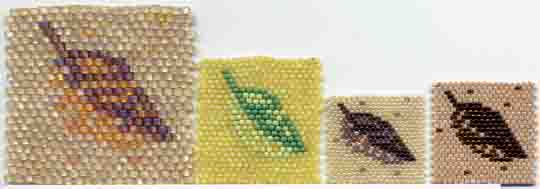|
Japanese Seed BeadsJapanese seed beads come in a gazillion colors, which makes them a first choice for lots of beadwork and for lots of beaders. They are generally longer in length than corresponding diameters of European seed beads. Their holes are larger, making them much easier to use in any design that requires a lot of passes of thread through a bead. It wasn't until I was researching this article that I learned that the Japanese bead-makers make 3-cuts and charlottes as well as regular seed beads and cylinder beads. Cylinder beads deserve their own page, but first I want to show you the difference in aspect ratio between the different sizes of beads. Some folks are not familiar with the term, but everyone knows the effect when they see it. Aspect ratio is the relationship of height to width. The most common example in computer land is the difference between printing in portrait mode and landscape mode. In beads, the difference in shape of different types and sizes of beads can make a real difference in how your work turns out, especially if you are following a pattern. Early on, some people used counted cross stitch patterns as bead graphs. Since the beads are not square, the pattern was somewhat stretched out. This is okay with some subject matter, and fairly disastrous with others. If you use a pattern that was designed for cylinder beads and make it with regular Japanese seed beads instead, you will get a different result. I made up some samples of a simple leaf pattern to give you the idea. Those of you with an eye for detail will notice that following a pattern is not my strong suit, but all the sample swatches use the same number of beads, mostly in the same places!
From left to right, these swatches are Japanese size 8/0 beads, Japanese size 11/0 Dyna-Mites beads, Japanese size 15/0 beads, and Japanese cylinder Delica beads. I find the different angle of the leaf interesting. These samples are 24 beads tall and 19 rows wide. The one in size 11 beads is almost square, while the one in size 15 beads is pretty squashed down, with the leaf appearing much closer to horizontal. Each of the Japanese seed bead companies has a website with good information available, including color charts, size data, and information on which finishes may be more fragile in response to light, chemicals, sweat, etc. The English language version of the sites are a bit awkward in their use of language, but since most of the information is in pictures or graphs, they are extremely useful. You can find the Toho Beads site here. Toho claims that their beads have larger holes than their competitors beads, allowing more thread passes and giving you more beads per kilo. If your work uses massive quantities of beads (Liza Lou, are you listening?), you might save by buying Toho. The Matsuno Beads site provides pictures of each bead shape along with size and weight specifications, and photos of their color charts. The
Miyuki Company site
has the usual size and shape specs and color charts, plus information on Delica color and durability, and charts to convert colors from Delicas to round seed beads. They also feature a very nice pictorial article on the process of making seed beads.
Return from Japanese Seed Beads to Seed Bead Info
|


